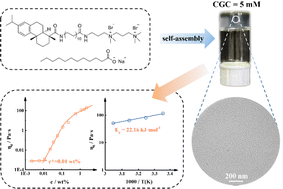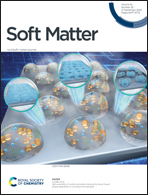Rheological behavior of thread-like fiber solutions formed from a rosin-based surfactant with two head groups†
Abstract
Wormlike micelles are conventional aggregates that exist in viscoelastic solutions. However, to achieve a solution with prominent viscoelasticity, rather high concentrations of surfactants are usually required due to the flexibility of aggregates in solution. If thread-like aggregates with rigidity can be formed by surfactants, the solutions are expected to show strong viscoelasticity at very low surfactant concentrations. Herein, A novel rosin-based quaternary ammonium surfactant with two head groups (abbreviated as R-11-3-DA) was synthesized. Cryogenic transmission electron microscopy (Cryo-TEM) images showed that flexible nanofibers with diameters of about 7–8 nm and lengths of over 1 μm were formed in the 1 : 1.5 R-11-3-DA : SL solutions. The rigidity of the aggregates seems to be inherited from the rigidity of the surfactant molecules. The novel aggregates endow the solutions with remarkable viscoelasticity at very low concentrations, with a critical overlap concentration of 0.01 wt% and a critical gelling concentration of 0.58 wt%. The rheological behavior of the solutions also shows excellent shear resistance and weak sensitivity to temperature below the critical gelation temperature (Tgel). This work reveals the advantages of viscoelastic solutions containing flexible nanofibers. The design principles of new molecular structures and system compositions can be applied to the preparation of smart soft materials based on the self-assembly of molecules.



 Please wait while we load your content...
Please wait while we load your content...